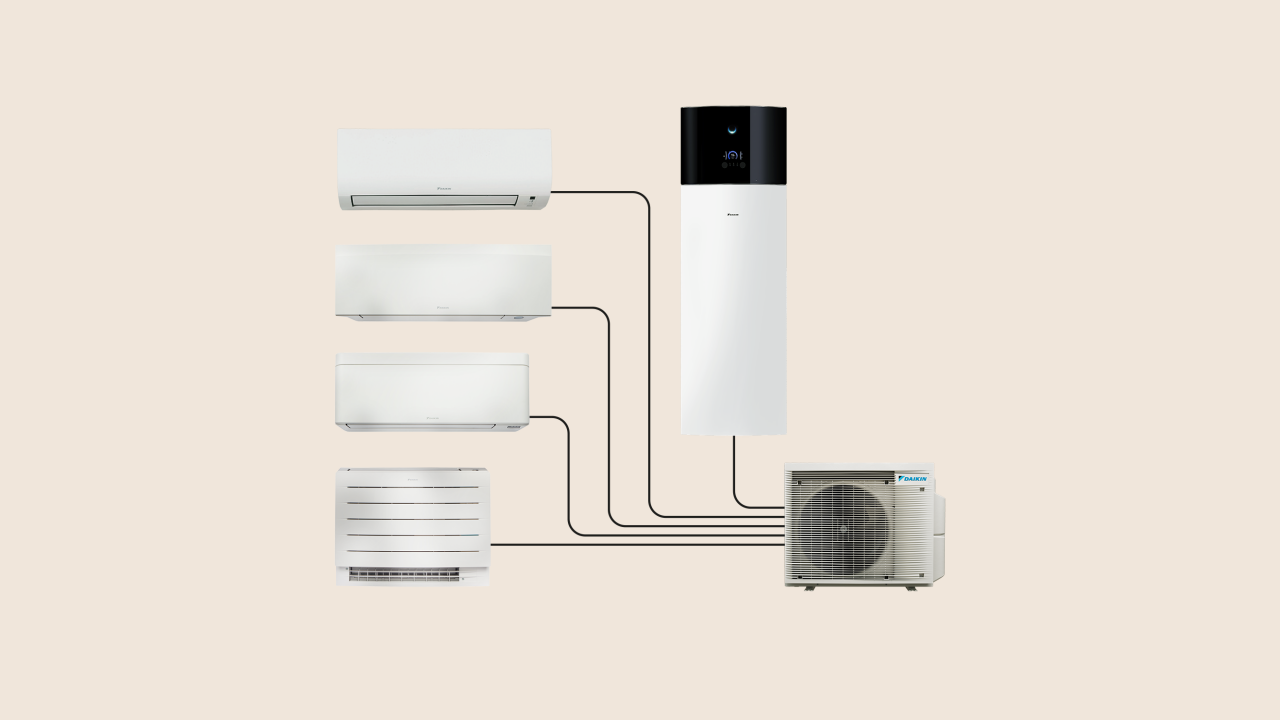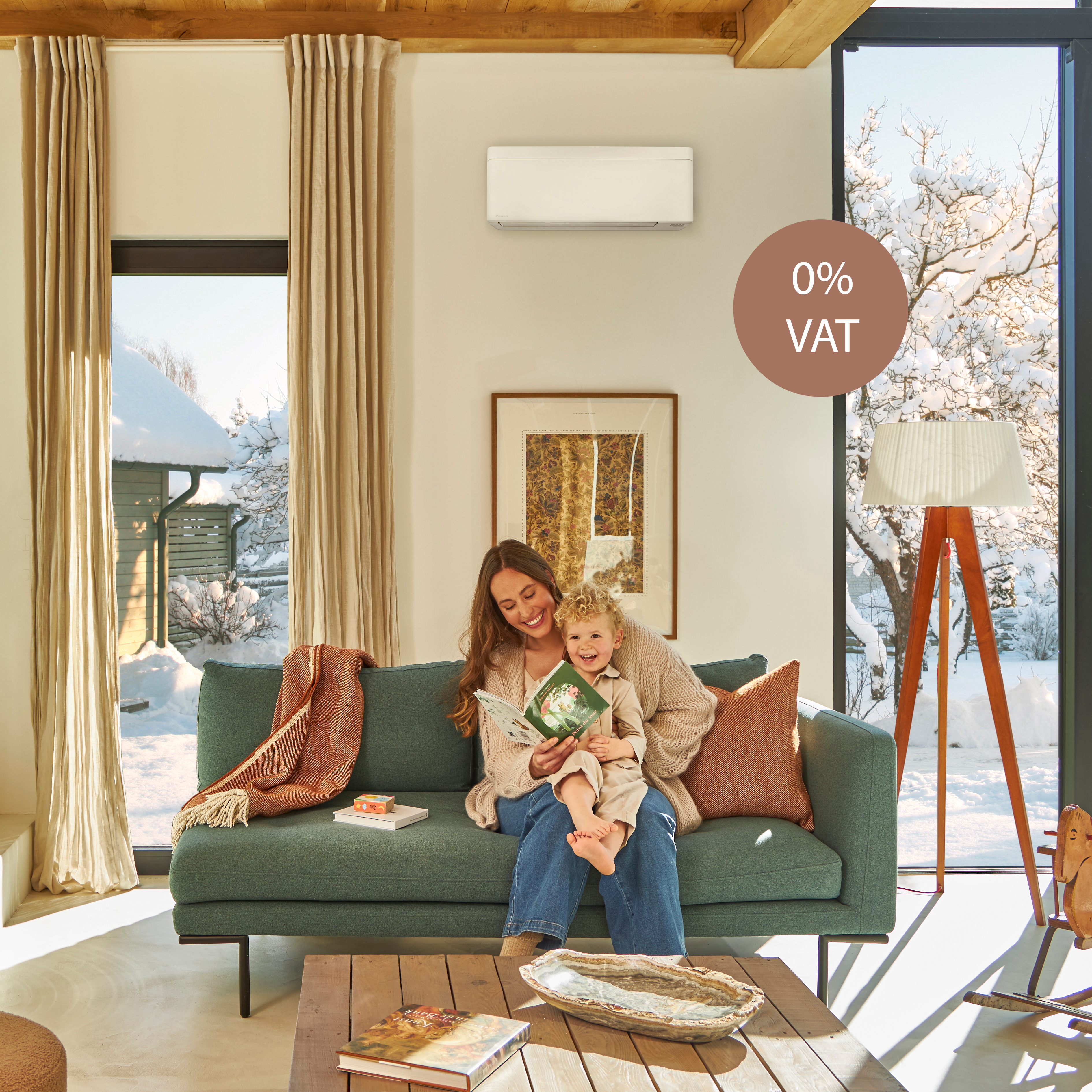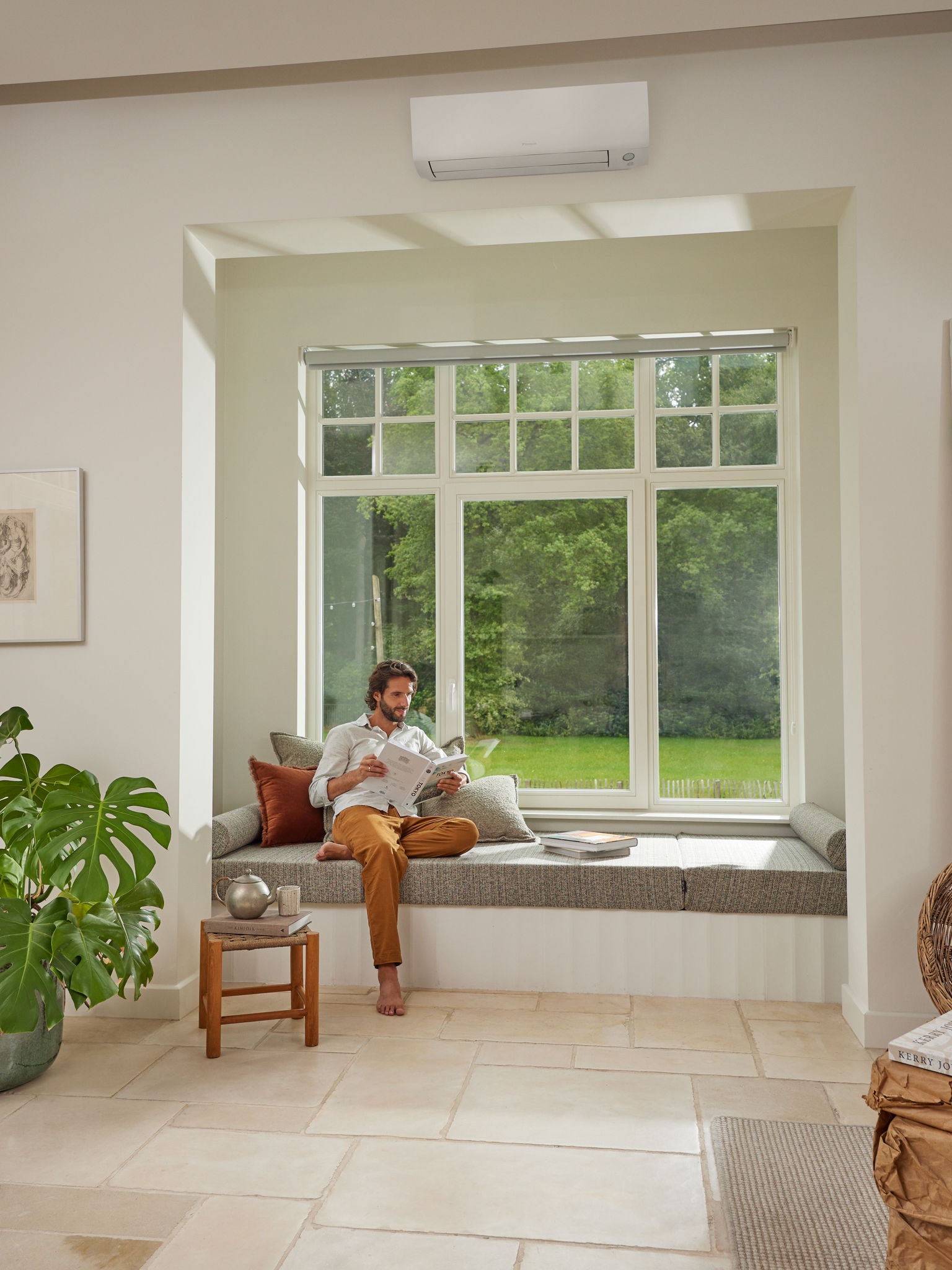Designed to suit your style
- Wall-mounted units
- Floor-standing units
- Concealed ceiling units
Our wall-mounted air-to-air heat pumps come in different styles and colours. With their unique design, they blend in with their surroundings and fit in with your taste

To distribute air effectively throughout the room, these units fit seamlessly into modern interiors thanks to their smooth design and compact size

With these units installed discreetly in false ceilings, you'll never know they're there: only the grilles are visible. You get all the benefits, with minimal impact on your space and decor

Discover our most popular air-to-air heat pumps
Compare models (1)
Compare models
Colors
Colors
Summary
Sound pressure
Sound pressure
Heating cooling capacity (kW)
Heating cooling capacity (kW)
Energy label heating
Energy label heating
Energy label cooling
Energy label cooling
# indoor units on a single outdoor unit (multi)
# indoor units on a single outdoor unit (multi)
Dimensions indoor unit (hxwxd)
Dimensions indoor unit (hxwxd)
Compare our models
Multi-room cooling and heating
- Multi system
- Multi+ system
- Pair system
Multi: Heating and cooling up to five rooms
Heat and cool multiple rooms by connecting one outdoor unit with up to five indoor units

Multi+: Multi-room heating and cooling control plus hot water for your home
Heat and cool your home, and generate hot water, by connecting one outdoor unit with maximum four indoor units and a hot water tank

Pair system: for one room
Heating and cooling for one room by connecting one outdoor unit with one indoor unit
This is what some of our customers say
Watch & learn about air-to-air heat pumps
Settle back and enjoy learning all you need to know about our solutions with these stories, carefully selected for you
More information about air-to-air heat pumps
The air-to-air heat pump indoor unit is the part of an air-to-air heat pump system that’s located within the home, and provides the conditioned air into the space.
The choice of an air-to-air heat pump indoor unit depends on your specific needs but it's important to understand how the system works as a whole. There are different air-to-air heat pump systems (also known as air conditioners), each with its own unique characteristics. One of the most popular types used in homes is a split system, which is split into two units: one indoors and one outdoors. While heating, the outdoor unit extracts heat from the outside air and transfers it inside via the indoor unit, or reverse when cooling your home.
There are three types of air-to-air heat pump indoor units:
Wall-mounted units
Wall-mounted models (Stylish, Ururu Sarara, Daikin Emura, Perfera,) come in different sizes and colours to match with your interior.
Floor-standing units
Floor-standing models (Perfera Floor) are compact air conditioner that fit perfectly under a window sill or in a room where the height is limited.
Concealed ceiling units
Concealed ceiling units. If you don't want a visible indoor unit, a concealed air-to-air heat pump can be installed in suspended ceilings or false walls.
An air-to-air heat pump (also known as an air conditioner) is typically composed of two units: The indoor and outdoor unit. These are usually called ‘split’ systems.
The split outdoor unit, mounted on an exterior wall or positioned in a garden or on a roof, is the part of an air-to-air heat pump that contains the compressor, propeller fan, circuit board and heat exchanger. The outdoor unit compresses the refrigerant that extracts or emits heat or cold in the room to or from its companion indoor unit.
Yes, and if you renovate your property and switch to renewable air-to-air heat pumps, you will add value to your renovated home, the environment and your pocket. Heat pumps can be installed in almost any home. There are, however some considerations that may need to be addressed, particularly regarding insulation. In order for a heat pump to function at its most efficient, your home needs to be well-insulated to prevent as much heat from escaping as possible. A suitably qualified heating engineer can advise you on what needs to be done in your home in order for it to be appropriate for a heat pump system. This might include upgrading the insulation of your walls and roof. You also need to consider location. The outdoor unit will need to be installed outside your home and should be in a place that you can access easily when you need to clean the unit, adjust its settings or have the heat pump serviced.
Yes, an air-to-air heat pump (also known as an air conditioner) can bring hot water to your home. With Daikin's Multi+ solution, heating, cooling and hot water are supplied with one system. It connects up to three units and one domestic hot water tank and is compatible with a 90 and 120-litre tank and a wide range of indoor units, offering unrivalled flexibility. Our Multi+ solution includes an intuitive full-text display on the domestic hot water tank for monitoring and adjustment of all settings, including scheduling and water temperature.
Daikin's air-to-air heat pumps (also known as air conditioners) can give you relief from your allergies because they can capture the allergens in the heat pump filter and improve the quality of air that you are breathing. Not only do our air-to-air heat pumps keep you warm and cool but they are also removing pollutants, pollen and particle matter from your breathing space.
Some Daikin units are also equipped with a Flash Streamer and different filters like the titanium apatite deodorising filter or the silver allergen removal filter, which are able to reduce the pollutants in the air quickly and efficiently.
No! Furthermore, our air-to-air heat pumps (also known as air conditioners) can help reduce the symptoms of allergies. Daikin integrates multiple filters in all its air conditioning units: titanium deodorising filters, silver allergen filters and flash streamers remove dust and capture bacteria. With proper air conditioning maintenance, and as long as they are cleaned regularly, these filters will provide cleaner, healthier air for everyone to breathe.
For your heat pump to function as it should, it is essential that the system is installed correctly. Only an authorised technician should carry out the installation and in a suitable location. The surface must be firm enough to withstand the weight and vibrations of the unit and there must also be sufficient space for airflow and for connecting pipes and power cables. Any plants or shrubs that may be located near your heat pump should be at least a metre away and regularly pruned. The pump should also be installed in a place that’s easy to access for services and other general maintenance.
We often get asked why we can’t put the heat pump inside. Could they not be placed in the loft or conservatory? The answer to this is no. This is because, after a few hours, the heat pump will have extracted all of the warmth from the trapped air, effectively turning this space into a freezer. This is why air-to-air heat pumps need access to the free-flowing outside air.
We advise having a service done by a qualified engineer once a year. Scheduled servicing, regular maintenance spot-checks and routine cleaning of the system will extend its lifespan and maintain its energy efficiency.
Here are some signs your air-to-air heat pump (also known as air conditioner) needs immediate maintenance:
If your air conditioner unit makes more noise than usual, the filters may be clogged. Clean the unit by removing dust with a vacuum cleaner. If the same noise persists or you hear a gurgling sound, there could be a mechanical issue. A qualified technician should then be called to examine the unit.
Case studies
Discover how Daikin air-to-air heat pumps has transformed homes into cool, comfortable, and energy-efficient spaces.
Experience the Daikin difference
We've selected some informative and inspirational articles for you to learn more about how Daikin can help you





























































